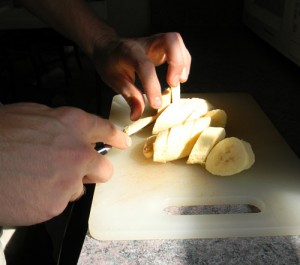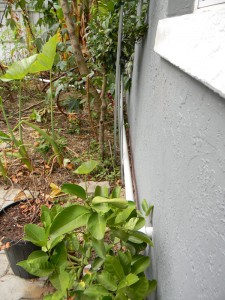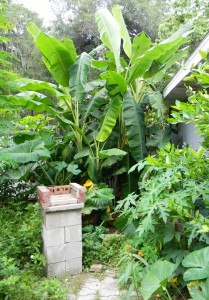 As drought continues to wreak havoc in much of the west, there’s a new interest in how much water we waste.
As drought continues to wreak havoc in much of the west, there’s a new interest in how much water we waste.
In a survival situation, water is your #1 priority.
It’s also #1 for plants.
Unfortunately, many of us have homes that were designed to be linked into either wasteful septic systems or municipal sewers.
Why do I say “unfortunately?” After all – isn’t our modern sanitation system a glorious thing that separates us from the savages and keeps us safe from cholera and other yuckiness?
Sure, to an extent. But like many modern innovations, our “waste” disposal system is incredibly wasteful. Many primitive farming methods saved everything they could, including human manure and urine. They were also very meagre in their water usage, unless the aquifer-draining mechanized agriculture of today.
Though you may not be ready to install a full composting toilet system or, simpler, start using your urine as a liquid fertilizer, you might be ready to start looking at ways to reuse greywater in your gardening plans.
I’ve considered quite a few plans for reusing greywater on my own property. I love the concept of greywater bogs, retention ponds, reed beds, etc. – yet it’s very hard for me to access the greywater in my house. Slab construction is a pain. In order for me to reuse the water from our washing machine or our showers and bathtubs, we’d have to do major surgery on the plumbing system. Everything gets sent into our septic tank, goldangit. Everything.
All the kitchen sink water now runs outside and down a pipe into an area a few feet from the house, sloping downwards at a slight angle towards the garden. The last few feet of PVC is drilled with a plethora of holes. I threw mulch over the pipe then planted water-loving useful and edible plants.
For a month or so I poked around and thought about various ways to reclaim some of the water. I considered pumping bathwater out the windows… putting buckets under sinks… even cutting a channel through my office from the laundry room to the outdoors.
Then I thought, “Hey… there is ONE source of wasted greywater near a wall… and the garden! The kitchen!”
Our kitchen window looks directly out on the gardens, through an espaliered Key Lime tree. It’s also just about our double sink. That sink became my first serious experiment with greywater.
One afternoon I picked up some PVC and cement, along with some Teflon tape and a good concrete chisel and a masonry bit for my trusty DeWalt drill.. Then I started doing damage.
It was easy to disconnect the sink drainpipe, though it took some time to punch a good hole to the outdoors and widen it enough to accept a piece of 2″ PVC, but I got the whole project done in a few hours. Look!
All the kitchen sink water now runs outside and down a pipe into an area a few feet from the house, sloping downwards at a slight angle towards the garden. The last few feet of PVC is drilled with a plethora of holes. I threw mulch over the pipe then planted water-loving useful and edible plants.
Check it out:
 My plants included bananas (edible fruit), malanga (edible roots), papyrus (paper for the apocalypse) and a chaya (edible leaves). They’ve all grown at an insane rate thanks to the constant moisture as well as the abundance of food scraps, coffee grounds, etc. that are constantly going down the drain.
My plants included bananas (edible fruit), malanga (edible roots), papyrus (paper for the apocalypse) and a chaya (edible leaves). They’ve all grown at an insane rate thanks to the constant moisture as well as the abundance of food scraps, coffee grounds, etc. that are constantly going down the drain.
One thing we’ve had to remember is to not put anything down the sink that would hurt the plants.
Once you have greywater running out of your house, you need to keep that avenue free of plant-destroying chemicals such as bleach, salt, harsh detergents, paint thinner, lye, muriatic acid, drain cleaners, formaldehyde, plutonium and so on.
As long as you stick to mild detergent and cleaners such as vinegar, you’re fine. A little salt doesn’t seem to cause much harm either.
Over the year and a half I’ve had to clean the pipes on this system about every three months. When the sink stops draining, I go outside, pop the pipe open near the house (it’s unglued at the top for easy access), then send the garden hose down it and turn the water on full. Easy.
The banana trees have been the real winners in this experiment. This year we have six hands of bananas ripening out there! Not bad for a roughly 10′ x 10′ banana bed, especially since we’re outside the tropics and bananas can’t stand the winters here. Thanks to the extra water and nutrition, they regrow and recover from the cold a lot faster than the other bananas I planted out in my yard. Those rarely bear, if at all.
Wasting anything – especially water – doesn’t make sense. It particularly doesn’t make sense when it comes to survival.
Just a few months after installation the bananas were thriving.
Are there ways you’re re-using greywater? Let us know!
David Goodman is a naturalist and hard-core gardener who has grown his own food since 1984. At age five, he sprouted a bean in a Dixie cup of soil and caught the gardening bug. Soon after, his dad built an 8’ by 8’ plot for him and David hasn’t stopped growing since. David writes a regular column for Natural Awakenings magazine in North Central Florida, posts on the Mother Earth News blog, owns a nursery of hard-to-find tropical edibles and grows roughly 1.5 zillion plants on his one-acre homestead. In mid-2012, he launched www.floridasurvivalgardening.com as a place to share his ongoing experiments with tropical and temperate crops. He currently has over 20 intensive beds, multiple field plots, over 100 fruit trees, two food forest projects in different climates and a series of ongoing experiments in-progress – all of which bring him closer each day to complete food security. David is a Christian, an artist, a husband, a father of seven, a cigar-smoker and an unrepentant economics junkie. Visit his daily blog here: Florida Survival Gardening Follow him on Twitter here: http://twitter.com/DavidTheGood


